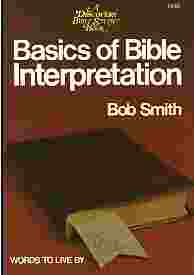Basics of Bible Interpretation
Basics of Bible Interpretation
by Bob Smith
 This is a primer on Interpreting the Bible by Pastor Bob Smith. He has 13 chapters on how to interpret the Bible, and his form is very easy to read and understand.
This is a primer on Interpreting the Bible by Pastor Bob Smith. He has 13 chapters on how to interpret the Bible, and his form is very easy to read and understand.
Although I find this work by Pastor Smith very good, I would caution that he may use other versions than the KJV. In Chapter 2 he endorses “many versions” as a blessing and mentions the Philips paraphrase and also the Living Bible.
People often wonder which English translation of the Bible they should use, and they are troubled by the multiplicity of versions available today. I’d like to suggest that this is not a problem, but a blessing. Each translation represents untold hours of careful scholarship through which the translators endeavored to carry over the best sense of the original language. No translation is a perfect expression of the original, simply because there are often no word-for-word equivalents in the two languages. That’s why biblical scholars study Hebrew and Greek, plus a number of related languages, to get as close as possible to the original intent. All of the scholarly translations, however, are sufficiently accurate to be trusted to give us an understanding of the truth. So, whether you choose to study the New American Standard Version, the Revised Standard Version, the New International Version, or the older King James Version, you can hear God speak to you through any of them.
The most practical way to resolve a problem in the English text is to compare translations when in doubt, even utilizing the paraphrases, such as Phillips’ New Testament and The Living Bible. When using these, however, it is wise to rest your confidence more heavily on the standard versions. In my opinion, the Phillips translation has stayed much closer to the original language than The Living Bible, but either paraphrase is useful if you are careful to compare and weigh the different renderings. Eternity magazine published a helpful review of English versions which is listed in the bibliography in the Appendix.
Personally I see these two paraphrases as well as the NIV as dangerous Bible versions. They are very inaccurate as they seek to put God’s Word more in “something different than what we always have had in the KJV” than something more accurate. Yes there are some very difficult passages in the Bible, but it is better to study these words, phrases, and passages in the original languages than use paraphrases. If the student does not know the original languages then use good conservative commentaries that are written by men who are experts in these languages. But somebodies opinion about a passage doesn’t pass much confidence, and this is basically what these paraphrases are, an opinion by people who are looking for “something different” rather than something original, the “old paths”.
Notwithstanding, Smith’s work has a lot of merit on how to interpret the Bible.
Contents of Smith Basics of Bible Interpretation
Introduction
Acknowledgments
PHASE 1: BACK TO BASICS
For everyone who wants to understand what God has said to man in his Word.
1. Words of Life
2. Is Anybody Listening?
3. The Goal of Bible Study
4. Interpretive Principles
5. The Interpretive Process
6. Bible Study Approaches
PHASE 2: FIGURATIVE LANGUAGE
A look at the fascinating world of metaphoric and symbolic language.
7. Figures of Speech
8. The Language of Analogy (especially Parables)
9. Allegories and Types
PHASE 3: BIBLICAL LANGUAGES
A bit of insight into the thought patterns of the Hebrew and Greek language behind our English text.
10. The Greeks Had a Word for It
11. Helps on Hebrew: What Every Bible Student Needs to Know About Hebrew (by David H. Roper)
HELP: See our Greek Geeks (for theWord) Corner
PHASE 4: STRUCTURAL ANALYSIS
The final step: analyzing the structure and summarizing in outline form.
12. Getting It All Together
INDEX to the APPENDIX and APPENDICES
Download
Download “smith-basics-of-bible-interpretation.gbk_.twm”
smith-basics-of-bible-interpretation.gbk_.twm – Downloaded 13 times – 404.00 KBMore works on Bibliology
- Grant Numerical Structure of Scripture
- Gray – Inspiration of the Bible
- Gray – Synthetic Bible Studies
- Gray, J.M. – Inspiration of the Bible: Definition, Extent and Proof
- Gunn Christocentric Principle of Hermeneutics
- Ironside, H.A. – The Greatest Text in the Bible
- Lin The Inspiration and Inerrancy of the Bible
- McConnell Understanding Scripture
- Philpot, J.C. – Precepts of the Word of God
- Pink – Divine Inspiration of the Bible
- Reed, D. Allen – Fundamental Doctrines of the Bible
- Smith – Basics of Bible Interpretation
- Smith Fruit from the Tree of Life
- Thomas – Biblical Hermeneutics: Foundational Considerations
- Tidwell Bible Period by Period
- Tidwell, J.B. – Bible Book by Book
- Torrey How to Study the Bible
- Torrey Principles of Biblical Interpretation
- Torrey Profitable Bible Study
- Torrey, R.A. – Difficulties in the Bible
More modules on Parables
- Arnot – Lesser Parables of Our Lord
- Arnot {Presbyterian}- The Parables of Our Lord
- Barry The Parables of the Old Testament theWord
- Edersheim Life and Times of Jesus the Messiah
- Franklin – Hermeneutics Class Notes
- Glover, T.R. – Jesus of History
- Mitchell Parables OT Spiritually Unfolded
- Smith – Basics of Bible Interpretation
- Stevens, William Bacon – Parables of the New Testament, Practically Unfolded
- Thompson – Nature, the Mirror of Grace (study of 7 Parables)

Most people buy a cup of coffee many times during a year. I spend my time and money writing good doctrinal content, and I am finding and formatting good old books for the Christian public to use in their studying the Bible. I have Bible college degrees where I have studied Greek and Hebrew. I have had donations over the years, but usually it is very little, like once every 6 months to once a year sometimes. One of my sites (I have 34 sites, about half are in English and the rest in Spanish) costs me about $10/month per site. Because the rent for having these sites on the Internet comes due every month, I have to pay it out of what me and my wife have to pay rent and food. Please consider a donation of any amount. Just a donation of the price of a cup of coffee can greatly help us with these costs and assure that new material is always coming.
-------- >>> Donate Today <<<--------
Even a small donation will help me greatly! Thank you! May God bless you for your prayers and your financial donations. (If you do not have a PayPal account, there is an option to donate using any bank or credit card even though you don't have a PayPal account.
